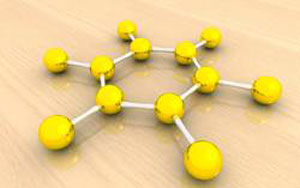| Posted: Aug 21, 2014 |
Neutrons investigate Einstein diffusion to support hopes for carbon nanotechnology
|
|
(Nanowerk News) Interest in carbon and its use in new technologies is very high right now. A lot of commercial and academic research and development is going into making nanometre sized systems out of it. In recent years these types of carbon based systems have yielded a range of potential commercially valuable properties that include superlubricity, with negligible friction between grapheme sheets and graphite surfaces, whilst super-diffusion was also observed within simulations of gold nano-clusters adsorbed on graphene.
|
|
One area of particular promise is in the development of carbon based synthetic molecular motors, man-made equivalents of protein based motors found in the body that power critical processes such as intracellular trafficking and cell division. Currently restricted to the lab, the potential wider use of these molecular scale motors is today limited by a lack of understanding of the surface physics and chemistry of carbon systems on the micro-scale. This is holding back progress on key parts of the motor, for example in the development of surfaces that slide past each other without any resistance or wear.
|
 |
| Molecular structure of benzene.
|
|
"At present a lot of the R&D into these carbon system is being done via experimental chemistry on a trial and error basis rather than by engineering these carbon systems from first principles, says ILL researcher Dr Peter Fouquet, who led the study. "This situation has been hard to resolve as the level of analysis required to make accurate predictions of system properties and dynamics is quite demanding and as a result a lot of the literature mechanisms are not correct."
To improve our understanding of these systems, Dr Fouquet and his team have been working on a relatively simple carbon system - benzene - to investigate its motion on a surface.
|
|
In 2009 Dr Fouquet, alongside colleagues from Cambridge University published a paper showing that benzene's movement can be described by a kind of surface motion first identified by Albert Einstein, called Brownian diffusion. It relates to the random motion of particles suspended in a fluid, liquid or a gas resulting from their collision with the quick atoms or molecules in the gas or liquid.
|
|
In their latest study in Carbon, Dr Fouquet and his team investigated in more detail the origin of this motion and how it is affected by altering the system temperature between 60K to over 140K, as well as changes in molecular density. To perform their analysis Dr Fouquet and his colleagues used the TOF spectrometer IN6 and the NSE spectrometer IN11 at the Institut Laue-Langevin (ILL) as well as by the back scattering spectrometer OSIRIS at the ISIS neutron source, which when combined allowed the team to create a detailed 2D model of the system. "The advantage of neutron scattering is you get information about energy exchanges and time profiles at the same time you get information on the length scale on which this happens," says Dr Fouquet.
|
|
In contrast to what was seen before the analysis revealed that the speed of diffusion decreased substantially when we increased the density of the particles - showing that the diffusion was almost like in a theoretically ideal liquid where slowing down occurs only upon collision between particles. The team also found the first evidence of a conversion to super-diffusive behaviour (diffusion with negligible friction) at the lowest benzene densities.
|
|
"This work has given us new insights into the nature of diffusion and the origins of friction", says Dr Fouquet. "The new, more accurate modelling of these processes will aid the search for low friction building blocks in nanotechnology, including those made of carbon. From a more fundamental physics viewpoint, what we have created here, an almost perfect browning gas 2D system, is also a brilliant test system for investigating the simple physics of colliding particles."
|

